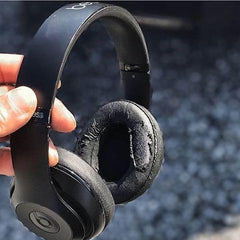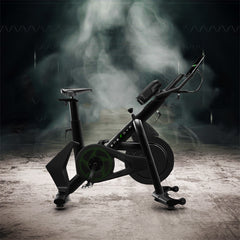Over-Ear Headphones for Running

What Are Over-Ear Headphones?
Over-ear headphones cover the ears completely. Even without active noise-cancelling technology, they’re generally considered to be the best at reducing the amount of ambient noise reaching the inner ear. You may also hear them called ‘big’ or ‘circumaural’ headphones. The Bose QuietComfort 35 II is one example of over-ear headphones.
By comparison, on-ear headphones are smaller and lighter. They press against the ears rather than covering them entirely. In-earphones are smaller still and deliver sound by fitting inside the ear. An earbud or AirPod sits outside the ear canal.
The popularity of the over-ear headphone amongst athletes and runners is growing. Partly, this is due to a perception (often true) that over-ear headphones have better sound quality. People may also prefer to wear their own headphones during a workout rather than spending additional money on sports branded pairs.Advantages of Over-Ear Headphones for Running
Studies have found that people tend to perform better during exercise when they’re listening to music. As over-ear headphones generally offer better sound quality than other types of headphone, you shouldn’t underestimate the added oomph you’re workout is getting from your Celine Dion’s playlist (your secret is safe with us).
When we’re talking about sports headphones, it can be difficult to image working out in over-ears. They sound too hot and too bulky to be comfortable during a run. Many of us consider in-earphones and earbuds to be the default sports headphone but earphones aren’t without their problems. Everyone’s ear canal is shaped differently and that often means that earphones don’t always stay in place during a workout. Big headphones do. During weightlifting, on-ears have been found to be particularly beneficial as there’s no real need to readjust once they’re on. Having to fiddle about with an earphone or earbud is annoying as hell and it makes it difficult to maintain form. Over-ears are often a better fit even for runners.
Over-ear headphones are generally more comfortable because they have thick padding on the cups. By comparison, on-ear headphones often have clamp against the ears and that can be painful over the course of an extended workout.
They’re great at isolating noise even without anti-noise cancelling technology. If you’re exercising on a treadmill in the gym, then it’ll save you from the noise of other people’s workout.
Over-ears allow you to take advantage of additional technology that may be beneficial both inside and outside the gym. For example, the Sony WH1000XM3 headphone now takes advantage of Google Assistant which has Google Translate.
There’s a good choice of open and closed-back headphones. Open-backed will be useful if you’re running outside as you can maintain situational awareness with any ambient noise giving a warning about approaching or upcoming dangers. Women who run alone outside and who enjoy listening to music might find open-backs beneficial for personal safety. Closed backs give better noise isolation and are useful if you’re running in a noisy commercial gym.
Disadvantages of Over-Ear Headphones for Running
Over-ear headphones are less portable than on-ear or in-ear headphones. They’re not as easy to throw into a gym bag or locker. More parts mean more things to break if you don’t handle them carefully.
They can be heavier, too, and that’s not always something you want if you’re running long distance.
Big headphones make it easier for us to forget the environment we’re in which can make running outside more dangerous. Sound is often an important warning sign of potential dangers and if you’re isolated from your environment you could miss the noise of an oncoming car, the shouts of passers-by or the horn of Gondor.
Headphones worn on the ear can make ears feel hot and that’s uncomfortable especially if you’re already warmed up from running.
Won’t Sweat Ruin My Over-Ear Headphones?
Yes, it will.
That’s why we only recommend that you wear them paired with a sweat-proof headphone cover. EarHugz come in a range of designs and all are fully reversible to black.
Over-Ear Headphones for Running
Sony WH1000XM3 Wireless
The Sony WH1000XM3 Wireless headphone is one of our favourite gym headphones. It’s super comfortable thanks to additional padding in the cushions and a curve to the headband that allows for a closer and more secure fit. What’s great, too, is that you can use its ‘personal noise-cancelling optimizer’ to analyse the shape of your head and improve the fit — especially important if you wear glasses.
Sony’s Sense Engine technology claims to cut out up to 90% of ambient noise. Perfect for when you’re trying to run in a noisy gym. Quick attention mode, however, ensures that you don’t miss any important sounds — like someone talking to you.
You can easily skip tracks, change volume, answer and end calls on the run by tapping the earcup. You also get access to Google Assistant and its real-time Google translate function — handy if you’re working out overseas.
Battery life is around 30 hours but you can get 5-hours of playback from a 10-minute charge.
These fold down easily and are relatively lightweight on the head.
Jabra Move Wireless
The Jabra Move and Jabra Move Style Wireless is designed to be used on the go. Controlling music from the headphone is easy and the sound is clear thanks to the Move’s 40mm drivers.
If you tend to take calls during your run, then you’ll find the sound quality is very clear and crisp. Jabra made their name from communications headsets so we’d expect nothing less.
The adjustable headband is both comfortable and secure making it ideal for running.
Battery life for the Move is only around 8 hours but with a price point of around £50 ($65), that’s understandable. The Style Wireless offers around 14 hours.
These fold down and are easily stored between runs.
One additional thing we’ll mention is that neither the Move nor Move Style has sweatproof covers. This is despite Jabra’s blog suggesting that they’re the ‘best wireless headphones for jogging’. None of the headphones on this list are sweat-resistant BUT Jabra is the only company not to make this clear. Good headphones nevertheless, but remember to add a pair of EarHugz before hitting the treadmill or track.
Beats Studio3 Wireless
We’re including the Beats Studio3 Wireless headphones but they’re only worth listing to if you’re an iOS user. This is mostly thanks to Apple’s W1 chip that means the headphones carry an impressive 22-hour charge when wireless is on and up to 40-hours when it’s off. Fast fuel gives 3-hours of playback from a 10-minute charge. All of this becomes very average, however, if you’re an Android user.
Apple’s W1 chip also gives a reliable pairing between the headphones and your device.
Beats has always been pretty heavy on the bass which may be to your running playlist taste. Although, the company has recently cut back on the ‘bass bloat’.
Pure Adaptive Noise Control should help reduce ambient noise. It’s not quite up to the standard of Bose and Sony for noise-cancellation but it offers a reasonable reduction in any unwanted background sound.
Honourable Mentions
The Bose QuietComfort 35 II headphones offer a comfortable and secure fit for runners as well as impressive noise-cancelling technology. QC 35 II wearers can now benefit from Google Assistant and real-time language translation.
Skullcandy’s Hesh 3 was something of a surprise. The company has been known for producing garish headphones (albeit to some people’s taste) with less of an emphasis on performance than many aficionados would like. The Hesh 3, however, offers good value for money — the wireless headphone retails for around £89.99 — and could be useful for anyone willing to trial running wirelessly without breaking the bank.
Master and Dynamic MW60 headphones offers runners a wireless range of around 50 feet — ideal when you don’t want a phone or device next to or on your person in the gym. It has stainless steel hinges making it easy to take to and from the gym. Touch controls on the cups make it easier to listen to sound hands-free.
Do you run in over-ear headphones or are you an in-earphone or earbud runner? Would you be tempted to switch? Drop us a message in the comments below and let us know.
Don’t forget to check out the EarHugz sweat-proof collection by clicking the button below.









